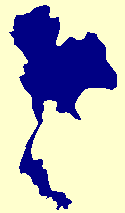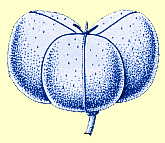
Flora of Thailand
Euphorbiaceae

 |
|
 |
W. Stuppy, P.C. van Welzen, P. Klinratana & M.C.T. Posa
Goto on this page:
Lour., Fl. Cochinch.: 586. 1790; Airy Shaw, Kew Bull. 20: 394. 1967; Kew Bull. 26: 349. 1972; G.L.Webster, Ann. Missouri Bot. Gard. 81: 114. 1994; Stuppy et al., Blumea 44: 88. 1999; Radcl.-Sm., Gen. Euphorbiacearum: 331. 2001; Stuppy et al. in Welzen & Chayam., Fl. Thailand 8, 2: 585. 2007; G.L.Webster in Kubitzki, Fam. Gen. Vasc. Pl. 11: 183. 2014.— Dryandra Thunb., Fl. Jap.: 13, t. 27. 1784. nom. rejic.— Elaeococca A.Juss., Euphorb. Gen.: 38.1824.— Aleurites J.R.Forst. & G.Forst. sect. Dryandra (Thunb.) Müll.Arg. in DC., Prod. 15, 2: 723. 1866; Pax in Engl., Pflanzenr. IV.147: 132. 1910.
Shrubs or trees, dioecious or monoecious. Indumentum consisting of simple hairs. Latex present in branches. Stipules early caducous, triangular-elliptic to elliptic. Leaves alternate, simple; petiole with 2 sessile or stalked glands adaxially at apex, red, 0.5-2 mm in diameter; blade symmetric, papery, broadly ovate, not lobed to 3- or 5-palmately lobed and then with a gland in each sinus, base truncate to emarginate; margin entire; apex and lobes obtusely or acutely acuminate to slightly cuspidate; both sides glabrescent, venation basally 3- or 5-palmate, pinnate along the midrib, with 4-6(-8) veins per side, distinct on both sides, ending open near margin. Inflorescences terminal, solitary, much-branched corymbiform thyrsoid panicles, protogynous with a solitary terminal pistillate flower and several staminate flowers per cymule when monoecious. Flowers slightly zygomorphic, white or reddish white to purple, pedicellate; calyx valvately rupturing into 2(3), often unequal lobes; petals 5(6), free, obovate, clawed; disc lobed with 5 or 6(7) free, erect glands. Staminate flowers: petals basally adnate to outermost stamens; stamens (7)8-12(-14), in 2 whorls, outer ones free except for base; inner ones united into a column, anthers 2-locular, basi- to dorsibasifixed, introrse. Pistillate flowers: ovary 3(-5)-locular, ovules 1 per locule, style present, stigmas bifid. Fruits large, ovoid to subglobose, tardily dehiscent rhegmas. Seeds obovoid to subglobose, dorsiventrally compressed, pointed or with a minute tip at the micropylar end, ecarunculate.
Three rather similar species, two in S.E. Asia main land (Myanmar, Thailand, S. China), one from Japan. Classification: Subfam. Crotonoideae, tribe Aleuritideae, subtribe Aleuritinae.
|
1a. |
Deciduous trees with flowers appearing before the leaves. Glands at the apex of the petiole sessile, tuberculiforim or cushion-shaped. Ovary 4- (or 5)-locular. Fruits spherical to subglobose or slightly compressed, surface smooth or faintly lineate, without grooves or ridges. |
|
|
1b. |
Evergreen trees. Glands at the apex of the petiole club-shaped, turbinate, apex cup-shaped. Ovary usually 3(-5)-locular. Fruits ovoid to subglobose, apiculate at the apex, surface wrinkled when dry, with distinct longitudinal grooves and ridges. |
1. Vernicia fordii (Hemsl.) Airy Shaw, Kew Bull. 20: 394. 1967; Radcl.-Sm., Kew Bull. 28: 296. 1973; Stuppy et al., Blumea 44: 91. 1999; in Welzen & Chayam., Fl. Thailand 8, 2: 586, Fig. 96, Plate XXXII: 2. 2007.— Aleurites fordii Hemsl., Hooker's Icon. Pl. 29: tab. 2801, 2802. 1906.
Shrubs or trees, monoecious, deciduous with flowers appearing before the leaves, up to 20 m tall. Stipules 4-12 by 2-4 mm. Leaves: petiole (5.5-)20(-26) cm long, glands at apex sessile, tuberculiform or cushion-shaped; blades not to shallowly 3-lobed, (4.5-)10-25 by (3.5-)10-22 cm, length/width ratio 1-1.2(-1.4), apex subacute to obtusely acuminate to slightly cuspidate, ending in a small gland. Inflorescences usually bisexual, (3-)8-16 by 7-21 cm, few-flowered. Flowers 25-30 by 25-35 mm in diameter, reddish white to purple, suffused and veined with pink, yellow in the centre; calyx lobes 8-10 by 5-8 mm; petals orbicular-ovate to broadly spathulate, 20-35 by 8-20 mm, claw 3-6 by 1.5-2 mm. Staminate flowers: pedicel 8-18 mm long, disc glands subulate to triangular-elliptic, 3-4.5 by 0.5-1 mm, acute, somewhat fleshy; stamens (7)8(-14), the (4)5(-8) outer ones 7-10 mm long, the 3(-6) inner ones 11-15 mm long, anthers 1.5-2 by 0.5-1 mm. Pistillate flowers: pedicel 5-14 mm long; disc glands as staminate flowers, 2-4 by 0.8-1.0 mm; ovary 4(5)-locular, ovoid-subglobose, 4-5 by 3-4 mm; styles 4-5 mm long, shortly bifid. Fruits spherical to subglobose or slightly compressed, apically sharply pointed, basally stiped, abruptly narrowed into the base, surface smooth or faintly lineate, but without any grooves or ridges; 4-6 by 3-5 cm in diameter, dull brown when ripe, glabrescent. Seeds 20-25(-30) by 18-22 by 14-15 mm, conspicuously warty and ridged dorsally and ventrally.
T h a i l a n d.— Cultivated only, new record for Thailand: NORTHERN: Lampang (Mae Yuak), Nan (Pong).
D i s t r i b u t i o n.— Native of S. China, Myanmar and N. Vietnam. Cultivated in other subtropical regions, e.g., the South-eastern United States, where it escaped and naturalised.
E c o l o g y.— This species is adapted to cooler, more temperate conditions and is not suitable for cultivation in tropical climates.
V e r n a c u l a r.— Ma yao (มะเยา) (Northern); Chinese wood oil tree, Tung oil tree (English).
U s e s.— The seeds are pressed for oil; two varieties are won: White t'ung oil, drawn cold, is yellow, translucent, moderately thick and used in Central China for varnishing furniture and umbrellas, for oiling paper, and for lighting purposes. Black t'ung oil is extracted by heat and pressure, it is thick, blackish, opaque and cheaper than the other variety; in China it is used in putty for caulking boats and for varnishing them. In Europe and America it is also used in varnishes, paint, linoleum, etc.; it is of better quality than linseed oil. The seeds have drastic purgative properties and can cause severe poisoning if eaten raw. The seed remnants are used as manure in China.
2. Vernicia montana Lour., Fl. Cochinch.: 587. 1790; Airy Shaw, Kew Bull. 20: 394. 1967; Kew Bull. 26: 349. 1972; Stuppy et al., Blumea 44: 92, fig. 3. 1999; in Welzen & Chayam., Fl. Thailand 8, 2: 588, Fig. 97. 2007.— Dryandra vernicia Corr.Müllo, Ann. Mus. Hist. Nat. 8: 69, pl. 32, fig. 1. 1806, nom. superfl.— Elaeococca vernicia (Corr.Müllo) Spreng., Syst. Veg. 3: 884. 1826, nom. superfl.— Elaeococca montana (Lour.) Oken, Allgem. Naturgesch. 3: 1599. 1841.— Aleurites vernicia (Corr.Müllo) Hassk., Flora 26, Beibl. 2: 40. 1842, nom. superfl.— Aleurites montana (Lour.) E.H.Wilson, Bull. Imp. Inst. Gr. Brit. 11: 460. 1913.
Shrubs or trees, monoecious, evergreen, up to 15 m tall, dbh up to 22 cm. Stipules 3-5 by 2-3 mm. Leaves: petiole 4.5-15(-23) cm long, glands at apex club-shaped, turbinate, tip cup-shaped; blades not or very often 3- or 5-lobed, (6-)10-20(-27) by (4-)10-20(-28) cm, length/width ratio 1-1.4, apex and lobes acutely acuminate to slightly cuspidate, without a gland at the top. Inflorescences usually unisexual, staminate ones many-flowered, (10-)15-25 by 15-32 cm; pistillate inflorescences significantly smaller, (3-)5-12 by 4-15 cm. Flowers very fragrant, white, reddish brown in the centre, fragrant; calyx green at the base, otherwise deep pink to pinkish yellow, lobes 10-15 by 5-8 mm; petals narrowly obovate-spathulate, 15-35 by 6-10(-15) mm, claw 6-8 by 1.5-2 mm. Staminate flowers 15-35 mm in diameter; pedicel 7-12 mm long; disc glands subulate or cylindrical-fusiform, slenderly triangular in outline, very long and acute, 3-4.5 by 0.3-0.5 mm, somewhat fleshy; stamens (8-)10-12(-14), filaments pale light greenish to faintly pinkish, 5-9 outer 10-16 mm long, 3-5(-8) longer inner ones 12-21 mm long, anthers 2-2.5 by 1-1.5 mm, light yellow. Pistillate flowers 20-30 mm in diameter; pedicel rather short, stout, 3-6 mm long; disc glands shorter and wider than in the staminate flowers, 1-2 by 0.7-1 mm; ovary obovoid or ellipsoid and angular, 3(-5)-locular, 4-5 by 3-4 mm; styles 5-10 mm long. Fruits ovoid to subglobose with rounded-truncate base, apiculate at the apex, surface wrinkled with 3(-5) distinct longitudinal grooves and ridges and a few transverse ribs, 4-6 by 4-4.5 cm in diameter, sparingly pubescent, yellow. Seeds broadly obovate in dorsal view, pointed at the micropylar end, 20-30 by 20-25 by 11-15 mm, conspicuously warty and ridged dorsally and ventrally.
T h a i l a n d.— NORTHERN: Chiang Mai (Doi Chiang Dao, Doi Suthep, Wang Tao), Lampang (Mae Yuak), Nan (Pong); NORTH-EASTERN: Loei (Wang Saphung); SOUTH-EASTERN: Chanthaburi (Tho-op).
D i s t r i b u t i o n.— Native of S. China, Myanmar, Thailand and Indochina, also cultivated in Java and other tropical regions.
E c o l o g y.— Forests or thickets, disturbed places and margins of evergreen forest; soil: dry, sandy, granite bedrock. Altitude: sea level up to 1200 m.
V e r n a c u l a r.— Ma yao liam (มะเยาเหลี่ยม) (General); Chinese wood oil tree (English).
U s e s.— The oil is of commercial importance and used in about the same way as the oil from the seeds of V. fordii, i.e., for the manufacture of varnish, paint, linoleum, etc.